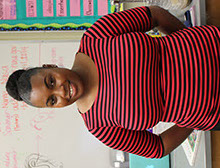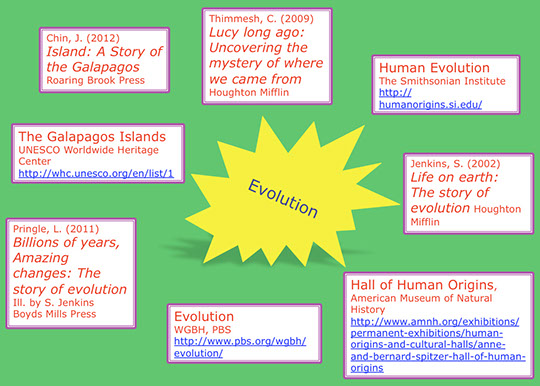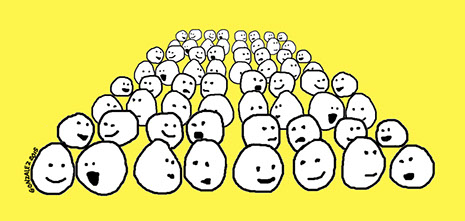Teaching Secondary Reading
A Resource for Improving Academic Literacy with Adolescents ©2015
Learning Activities
 According to Morrow and Gambrell (2011), best classroom practices in adolescent literacy instruction include:
According to Morrow and Gambrell (2011), best classroom practices in adolescent literacy instruction include:
1. Learning to read with a critical eye;
2. Engaging students metacognitively;
3. Ensuring that students have materials available that they can read; and
4. Creating contexts for students to learn together.
This page presents a few approaches that will help you to achieve these literacy practices.
For more on teaching vocabulary, click here.
1. Learning to Read with a Critical Eye
As part of the Common Core shift to "regular practice with complex text and its academic language," students are asked to engage in "close analytic reading." Close reading requires prompting students with questions to "unpack" complex texts so they learn to read those texts proficiently and independently.
- Reciprocal Teaching (Palincsar & Brown, 1984) is an approach to improve "comprehension-fostering and comprehension-monitoring" among adolescents. This method is used in the Reading Apprenticeship framework, since it is based on the notion that adult reading models apprentice, or guide the student to interact with texts in increasingly sophisticated ways. The method trains students in the good reader skills predicting, questioning, clarifying, and summarizing, then asks students to practice these skills in small, structured groups. See the sample below (7:03 min.). While the sample video shows a literature lesson, the method is applicable in all content areas, in fact, Reciprocal Teaching is most effective when practiced school-wide.
- Close Reading is a process in which the teacher guides students to read complex text through high-quality text-dependent questions. Students learn to ground all of their reading, writing and speaking with evidence from the text. In the video below (11:30 min.), educators discuss the reasons for text-based questions, and approaches toward doing so. Here is a link to an activity that helps teachers practice creating and evaluating text-dependent questions.
- Rhetorical Analysis is a way to understand, discover, and develop arguments for particular situations. While knowledge is based on various sorts of fact, the presentation of those facts is often in the form of an argument. Effective readers can identify the parts and evaluate the effectiveness of an argument. Effective writers can use rhetorical tools to persuade their readers. A rhetorical analysis takes into account the purpose, audience, genre, stance, and design of a given rhetorical situation. In other words, "the analysis explores not only what everything means in the given source (content), but also why the author wrote about it (the purpose), who the author is (background), how the piece was organized (structure), where and/or when it was published (forum), and the intended message conveyed to the audience (topic)." Below is a PowToon that gives a quick, student-friendly introduction to rhetorical analysis.
2. Engaging Students Metacognitively
- Cornell Note-taking is an approach developed by Walter Pauk, an education professor at Cornell University in the 1950s to systematically condense, organize, and study notes in a set format. The approach was popularized by AVID and is now widely used in schools. This slideshow explains the 5 steps: 1) Record, 2) Reduce, 3) Recite, 4) Reflect, and 5) Review.
- Graphic and Semantic Organizers are a tool to make conventional thinking visible for students. Beers writes that "graphic organizers are tools that help your brain think" (2003). This page offers nearly 40 different graphic organizers with Teaching Notes that include lessons and tips on how to use them in your classroom.
3. Ensuring that Students Have Materials Available That They Can Read
- Student Choice Reading is one of the most powerful ways to foster motivation to read among students. In order to become a "nation of readers," Miller (2010) notes that we must provide students with time, freedom, opportunity and structure. Building a classroom library supports student choice reading. Click here for recommended reading from adolescents.
- Silent Sustained Reading (SSR) is typically a school-wide approach to providing students with the opportunity to read. It is important that students have achieved a sufficient level of fluency, and that they are allowed to read texts that they have chosen and are interested in. Silent reading improves students' understanding because it helps them concentrate on what they are reading, rather than the pronunciation of individual words. When we read silently, we can form mental pictures of the topic being discussed. Also, we do not need to read one word at a time. When you encourage students to read silently, you are helping them develop the strategies they need for reading fast, ad with better comprehension. Trelease (2013) discusses some common concerns about SSR here.
- Text Sets are "multimodal, multigenre" (Cappiello & Thulin-Davies, 2012) collections, related by content or genre. They may include videos, photographs, primary source documents, music, podcasts, or radio broadcasts, in addition to traditional texts. An effective Text Set provides multiple entry points to the content for learners at varying levels of competence, and with differing interests and preferences. A sample text set on Evolution included:

The teacher can use each of the resource texts in her instruction. Also, she can allow students to read freely from the alternate texts.
4. Creating Contexts for Learning Together
Reciprocal Teaching, in number 1 above, is an effective way to structure your classroom such that you and your students are continually "creating contexts for learning together." Other
- Think-Pair-Share (T-P-S) is a simple, yet powerful approach that, when used properly, can help students engage with the topic and each other, while co-constructing shared understandings. In T-P-S, the teacher pauses in her presentation and asks students to consider a question (think), turn to a partner (pair) and discuss their response with the partner (share). Click on the image below to see a helpful infographic and listen to a short podcast on T-P-S from cultofpedagogy.com.
- Cooperation and Collaboration are two similar classroom approaches. Both support students to learn complex social and academic skills that support literacy improvement. Cooperative Learning aims towards consensus, while Collaborative Learning stresses the development of novel ideas or solutions. Different learning goals may require one or the other approach. Both approaches may be especially effective for students who are acquiring Academic English, because they require verbal practice.
The phrase "Cooperative Learning" covers many particular strategies. Typically (Johnson, Johnson & Holubec, 2007), students are seated in groups of 4 to 6 and work toward accomplishing shared academic goals. Johnson & Johnson et al. (2007) identify 5 essential elements for successful incorporation of cooperative learning in the classroom:
- Positive interdependence
- Face-to-face (promotive) interaction
- Individual and group accountability
- Interpersonal and small group skills
- Group processing
You will find a group of great starter approaches to use in Cooperative Groups at this link.
"Collaborative Learning" facilitates peer-to-peer learning as well, but focuses on developing the critical thinking needed to engage higher level literacy activities. See David Olio's comments on his classroom below:
In this Case Study, Mr. Olio discusses and demonstrates how he uses Tribes Learning Communities approaches to build his classroom learning environment, why he uses a "four corners" arrangement of desks, and how and why he encourages his students to show appreciation for one another.
Back to Main Vocab
Teacher Richelle Brooks
Photo by Stephanie Estrada
The views and opinions expressed on unofficial pages of California State University, Dominguez Hills faculty, staff or students are strictly those of the page authors.
The content of these pages has not been reviewed or approved by California State University, Dominguez Hills.
